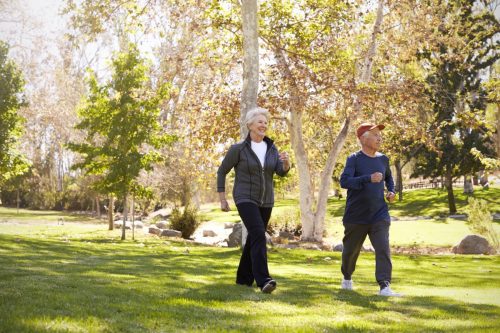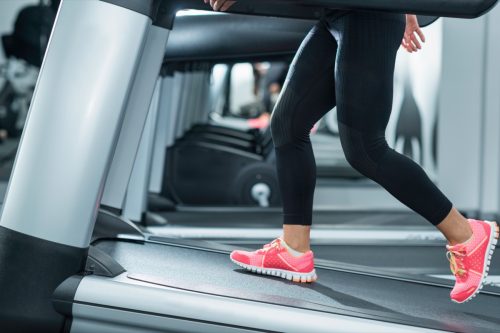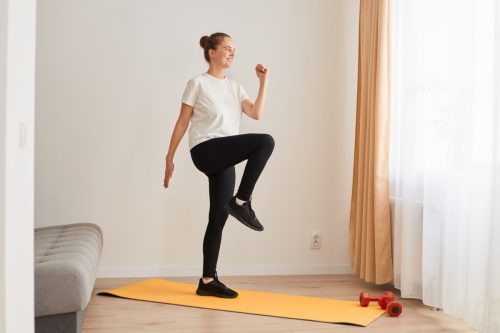6 Best Walking Workouts for Weight Loss
There are options for those who like to get outside, and those who prefer the treadmill.

Weight loss can be tricky, requiring you to strike a balance between a healthy diet, exercise, and any medical needs you have that could affect the process. If you've already decided on a meal plan to follow, you might also be looking to try out a new fitness program. But before you sign up for a high-intensity workout class, which can be both intimidating and expensive, consider just lacing up your sneakers and taking yourself on a walk. According to fitness experts, several walking workouts can be just as effective (if not more effective) for weight loss.
"Walking is one of the most underrated forms of exercise, in my opinion," Rachel Lovitt, certified personal trainer (CPT) and holistic movement coach, tells Best Life. "Walking is accessible to almost everyone and it's a full-body exercise! Not only is it great for your cardiovascular system and muscular system (increasing cardio and muscular endurance), but it's also great for lymphatic drainage, and your brain. The contralateral nature of the movement (opposite arm swings forward as opposite leg steps forward) helps connect the two hemispheres of your brain!"
Getting outside (or on a treadmill) and putting one foot in front of the other is a good way to get started, but experts recommend a few specific walking workouts that can help you drop stubborn pounds. Read on for the six most effective ways to walk for weight loss.
RELATED: 8 Ways to Motivate Yourself to Take a Daily Walk.
1
Interval walking

Interval walking includes different periods or "intervals" of walking, mixing high and low-intensity cardio. This workout can be done outside or on a treadmill—and the structure is great for anyone who wants to "maximize their time," according to Isaac Robertson, co-founder of Total Shape.
"This workout involves alternating between periods of brisk walking and short bursts of jogging or faster walking," Robertson says. "The varied intensity levels keep the body guessing and encourage the metabolism to remain elevated even after the workout is completed."
To get started with interval walking, Lovitt recommends deciding how long you're going to walk for. If you're just starting out, aim for somewhere between 10 to 20 minutes. (You can always up the time as you feel more fit!)
"Start with a slow walk for one to five minutes to warm up. Then, begin walking at a moderate pace for two to three minutes. Then, walk as fast as you can for 30 seconds," she explains.
Once you've completed this interval, you go back to the moderate pace for two to three minutes and repeat the alternating process until your workout is complete. Allot some time for a cool-down session at the end, walking at a slow pace for one to five minutes, Lovitt says.
Amber Sayer, MS, CPT, an NSCA-CPT, United Endurance Sports Coaching Academy (UESCA) Running Coach, and a senior fitness and nutrition writer at Marathon Handbook, also recommends wearing a heart rate monitor or a fitness watch so you can keep track of your rising and falling heart rate while walking.
"The higher you can elevate your heart rate, the more calories you will burn per minute, and if you can do high-intensity walking intervals—elevating your heart rate above 85 percent of your age-predicted max heart rate—you will get the post-workout boost in your metabolic rate seen with HIIT [high-intensity interval training] workout."
RELATED: 8 Easy Ways to Make Walking More Fun.
2
12-3-30

The 12-3-30 workout quickly went viral on social media, with many touting its effectiveness for getting in shape—and noting how challenging it is.
The three-number sequence represents the incline, speed, and length for which you'll be walking, according to Rachel MacPherson, Certified Strength and Conditional Specialist (CSCS), CPT, and pain free performance specialist.
"The 12-3-30 workout is a treadmill-based workout where you set the incline to 12 and walk at a speed of three miles per hour for 30 minutes," she explains, giving you fair warning that some treadmills don't go up to 12, which is a steep incline level.
If that's the case, choose an incline that feels doable for you but not too easy.
"Setting your treadmill to an ideal incline that gets your heart rate up is really all you need to do," MacPherson says.
RELATED: 5 Daily Walk Benefits You'll See in 1 Month.
3
Hill-walking

Hill-walking is a great way to introduce those inclines while also getting outside—and according to MacPherson, this workout is also a good option if you want to simultaneously improve strength and cardio abilities.
"Walking on a hill can boost your lower body, muscle, and strength, including in your hamstrings, quadriceps, and glutes. It also helps mobilize and work your hip knee and ankle extensors, which improves stability and protects your joints," she says. "Going up hills, you will hit your glutes and hamstrings more, while going down will target your quads. You'll also use your core to help propel you against or hold you back from the effects of gravity."
Look for a nearby trail that has hills you can walk on, or seek out a route in your neighborhood where there are one or two hills. You may have to go up and down the same hill a few times, but you can also introduce intervals into this workout by walking quickly up and then walking slowly back down.
Before you get started, MacPherson suggests warming up on flat ground "to get the blood flowing,"
4
Steady-state walking

Lovitt also recommends steady-state walking, which you may want to start with if you're new to exercise—or if you want to work out without having to overthink it. On this walk, you're walking at the same general pace, starting out slow to warm up and incorporating a cool-down period as well.
"The steady-state walking workout is great for beginners or anyone who wants to increase the amount of time they can spend walking. This workout will help increase your aerobic capacity and is more gentle on your body than interval training," she says.
For this workout, you're building endurance, keeping the same intensity for a set distance or amount of time—whichever is "more motivating to you," Lovitt says.
She continues, "If you're not sure where to start, I would choose 15 minutes or one mile. Of course, you know your body and your walking abilities, so choose something that is appropriately challenging for you, whether that's two minutes or two hours."
MacPherson also recommends walking to build your fitness, noting that when you start out, aim to walk at least a mile, or 2,000 steps. You can add this to your existing steps for the day—so if you get 5,000 in while working, you're already up to 7,000.
From there, you can continue to add distance after you've been following this routine for one to two weeks.
"Continue building on your habits by adding more distance every few days or weeks, depending on your schedule and fitness level," MacPherson says. "Aim to reach about 10,000 steps per day, which is about five miles, and add more as you are able to."
RELATED: 5 Clothing Items You Shouldn't Wear on a Walk.
5
Hiking

Similar to hill-walking, hiking is another great way to walk and lose weight.
"This is done outdoors in nature—through different trails and with hills—which would make the exercise more intense," Cinthya Viteri, fitness and wellness expert at National Coalition on Health Care, says. "This walking exercise is longer in distance and duration to help you build your endurance. You can go for longer hours."
Hiking can be more intense, however, and if you're following a trail, keep in mind that you'll need to conserve enough energy to finish the loop or turn around. But if you're feeling up to it, it's another form of walking that incorporates multiple aspects of physical fitness.
"For individuals seeking a multifaceted approach, walking on trails offers an exceptional path toward weight loss and stability," Seth Forman, head of education and training at Kayezen, tells Best Life. "The ever-changing terrain of trails engages various muscles and challenges balance, enhancing the effectiveness of the exercise while fostering a sense of equilibrium."
For more fitness advice delivered straight to your inbox, sign up for our daily newsletter.
6
Fast walking in place

Those with limited time or space can still walk for weight loss by walking in place, according to Viteri.
"You can perform this walking exercise in any area, such as your living room or patio. It does not require a big space," she explains. "You can start and end the fast-walking exercise by starting and ending slowly for five to eight minutes, depending on the time you will be walking."
In total, Viteri recommends walking for 30 to 60 minutes, but says you should listen to your body when it comes to pace.





















